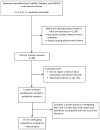Prevalence of Transgender Depends on the "Case" Definition: A Systematic Review
- PMID: 27045261
- PMCID: PMC4823815
- DOI: 10.1016/j.jsxm.2016.02.001
Prevalence of Transgender Depends on the "Case" Definition: A Systematic Review
Abstract
Introduction: A systematic review and meta-analysis was conducted to evaluate how various definitions of transgender affect prevalence estimates.
Aims: To evaluate the epidemiology of transgender and examine how various definitions of transgender affect prevalence estimates and to compare findings across studies that used different methodologies, in different countries, and over different periods.
Methods: PubMed, EMBASE, and Medline were searched to identify studies reporting prevalence estimates of transgender in a population. All studies were grouped based on the case definition applied to the numerator. Summary estimates were derived using a random-effects model for total prevalence of transgender and for male-to-female and female-to-male subgroups. Overall and stratum-specific meta-prevalence estimates (mPs) and 95% confidence intervals (CIs) were accompanied by tests for heterogeneity and meta-regressions to assess sources of heterogeneity.
Main outcome measures: The main outcome measure was population prevalence of transgender. Secondary outcomes included gender-specific prevalence estimates for male-to-female and female to male subgroups.
Results: Thirty-two studies met the inclusion criteria for systematic review. Of those, 27 studies provided necessary data for a meta-analysis. Overall mP estimates per 100,000 population were 9.2 (95% CI = 4.9-13.6) for surgical or hormonal gender affirmation therapy and 6.8 (95% CI = 4.6-9.1) for transgender-related diagnoses. Of studies assessing self-reported transgender identity, the mP was 871 (95% CI = 519-1,224); however, this result was influenced by a single outlier study. After removal of that study, the mP changed to 355 (95% CI = 144-566). Significant heterogeneity was observed in most analyses.
Conclusion: The empirical literature on the prevalence of transgender highlights the importance of adhering to specific case definitions because the results can range by orders of magnitude. Standardized and routine collection of data on transgender status and gender identity is recommended.
Keywords: Case Definition; Meta-Analysis; Prevalence; Transgender.
Copyright © 2016 International Society for Sexual Medicine. Published by Elsevier Inc. All rights reserved.
Conflict of interest statement
Figures
References
-
- Institute of Medicine. The Health of Lesbian, Gay, Bisexual, and Transgender People: Building a Foundation for Better Understanding. Washington, DC: The National Academies Press; 2011. - PubMed
-
- Cahill S, Makadon H. Sexual orientation and gender identity data collection in clinical settings and in electronic health records: A key to ending LGBT health disparities. LGBT Health. 2014;1:34–41. - PubMed
-
- Addis S, Davies M, Greene G, Macbride-Stewart S, Shepherd M. The health, social care and housing needs of lesbian, gay, bisexual and transgender older people: a review of the literature. Health Soc Care Community. 2009;17:647–58. - PubMed
Publication types
MeSH terms
Grants and funding
LinkOut - more resources
Full Text Sources
Other Literature Sources
Medical
Miscellaneous


